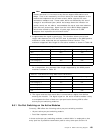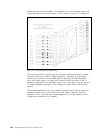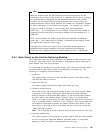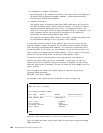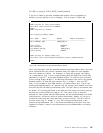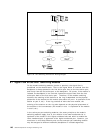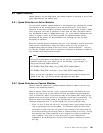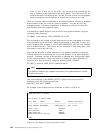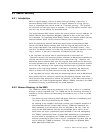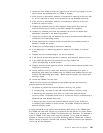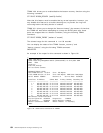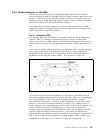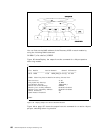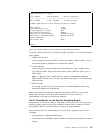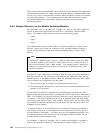
8.9 Beacon Recovery
8.9.1 Introduction
When a station detects a failure of token-claiming following a hard error, it
transmits Beacon MAC frames with an all-station address to its ring, pacing
them at a specified time interval known as ″T(transmit_pacing)″. This process
will continue until the input signal is restored, or until this station removes itself
from the ring for self-testing, as described below.
The issued Beacon MAC frames contain the issuing station′s source address, its
NAUN (Nearest Active Upstream Neighbor) address as well as the type of the
error detected. By inspecting these Beacon frames, the
beacon domain
(the two
stations between which lies the cause of beacon) can be determined.
When the beaconing station′s NAUN has copied eight of these Beacon MAC
frames, the NAUN station removes itself from the ring and tests itself and its
lobe (using Lobe Media Test and Duplicate Address Test MAC frames). If the
test fails, the NAUN remains out of the ring allowing the normal operation of the
ring to resume. If the test is successful, the NAUN re-enters the ring.
If the ring does not recover after a specified period of time known as
″T(beacon-transmit)″ the beaconing station assumes its NAUN has completed its
self-test and did not find any fault and has re-entered the ring. Therefore, the
beaconing station removes itself from the ring and tests itself and its lobe using
the same procedure as its NAUN. If the test fails, the beaconing station remains
out of the ring, resulting in the signal being restored to the ring and the normal
operation of the ring being resumed. If the test is successful, the beaconing
station re-enters the ring and continues to send the Beacon MAC frames.
If the ring does not recover after both the beaconing stations and its NAUN have
been tested, the error cannot be repaired by the attaching stations, and some
other function must intervene to resolve the problem. In the 8250, this function is
performed by the Token-Ring Management Module (TRMM), whereas in the 8260,
the beacon recovery is performed by the media modules.
8.9.2 Beacon Recovery in the 8250
The TRMM can detect beaconing conditions on the ring to which it is attached
through its token-ring MAC chip. The TRMM will use the following resources to
attempt to find the cause of the beaconing and disable a port or trunk or isolate
a module:
•
The token-ring map indicating MAC addresses and their corresponding port.
This map is built and maintained by the TRMM.
By listening to the neighbor notification process (one complete sequence of
Active/Standby Monitor Present MAC frames), TRMM can determine the
MAC addresses of all the stations that are attached to the ring. Then, by
using its own MAC address and also the knowledge that it has of all the
ports which are active (a phantom signal detected) in the hub managed by
this TRMM, it determines which of these MAC addresses are connected to
the hub which is managed by this TRMM and which MAC addresses are
external (connected to other hubs or are on a backplane ring other than the
one to which this TRMM is attached). The other hubs, can be 8228, 8230,
8250, 8260 and/or OEM hubs.
Chapter 8. 8260 Token-Ring Support 151



